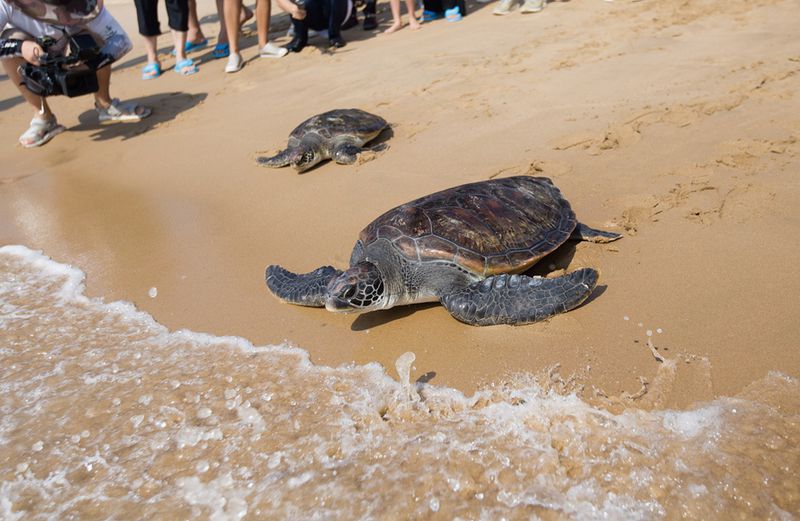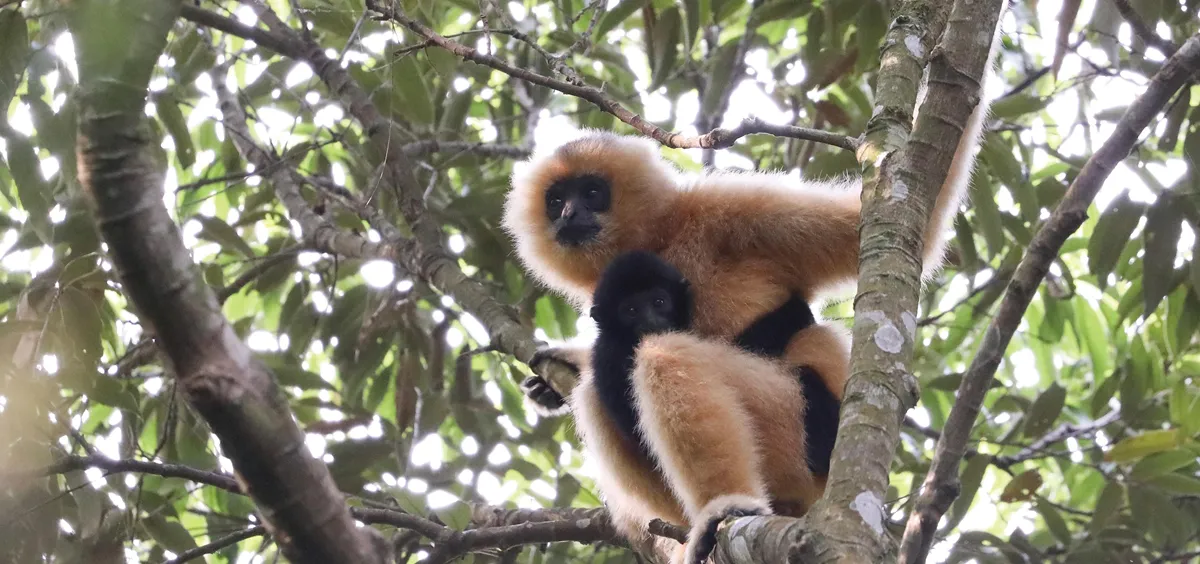Four rare and protected species to discover in Hainan
As Hainan became a more enticing destination for those of us on two legs, our animal friends began to see their habitats disappear. Luckily, some impressive conservation efforts in recent decades have been effective in rebuilding communities of fauna on land and in the sea.
Sea Turtles
After washing ashore into a mangrove forest near Haikou in 2016, a 71-centimeter-long green sea turtle had honey spread on his wounds to protect his skin. Found severely dehydrated and with festering stomach wounds, the turtle, now named Pang Pang, was transferred to Hainan Normal University’s Turtle Rescue Center. Lovingly nicknaming him “Fatty” in Chinese, volunteers fed Pang Pang a diet of fresh squid, meat, and vegetables, and administered daily nutrient injections. Fatty gained 8 kilograms before his release in 2017. Since the center’s founding in 2014, it has successfully rehabilitated around 50 hawksbill and green turtles.
The endangered hawksbill (Eretmochelys imbricata) and green sea turtles (Chelonia mydas) were, at one time, regular guests of Hainan’s pristine beaches, often spotted lumbering ashore to lay their eggs. Sadly, illicit poaching, habitat destruction by coastal developments, and plastic pollution have caused their numbers to dwindle drastically in recent decades. A market for combs, jewelry, and other products made from turtle shells, long coveted for their prestige and beauty in Chinese society, has led the species to be hunted and smuggled to China from throughout Asia, and even from as far away as the Caribbean. Some trade routes reportedly pass through Hainan and enter the mainland to markets all over the country.

Two sea turtles were released in April 2020 by the marine life team of Atlantis Sanya resort (VCG)
To combat the numerous perils faced by these reptiles, the island has become home to a host of turtle conservation efforts. In 2007, a Chinese American named Frederick Yeh returned to his ancestral home in Hainan, and was dismayed to find turtle meat and shells sold in local markets. Yeh founded the NGO Sea Turtles 911 in 2008, and built a unique turtle hospital in a “floating village” in Lingshui, where turtles could swim in natural sea water while receiving medical care. The NGO partnered with hotels like The Ritz-Carlton Sanya in Yalong Bay to build turtle shelters on the hotel premises, allowing tourists to see the recovering turtles up-close while gaining awareness of conservation efforts.
In 2014, Sea Turtles 911 invited basketball star Yao Ming to participate in the release of a rehabilitated turtle back into the ocean in Sanya. In 2016, the US ambassador to China, Max Baucus, helped release two turtles nicknamed “Harvard” and “Yale.” This event attracted international media, but shortly afterwards, Sea Turtles 911’s Hainan operations became halted. Taking over the protection and rehabilitation duties was the China Sea Turtle Protection Alliance led by the Ministry of Agriculture’s Fisheries Resource Management Bureau. Established on World Turtle Day in May 2018, the Alliance aims to improve the management of sea turtle habitats, crack down on illicit trade, and educate the public about conservation.
For those who want to learn more about turtle preservation on the island, the Hainan Biodiversity Museum (海南生物多样性博物馆) has hosted over 700,000 visitors since its founding in 2000. Professor Shi Haitao, a founder of the museum, has expanded turtle preservation to the remote Xisha Islands (西沙群岛), where he also educates fishermen on turtle protection. The islands hosted 52 turtle nests in 2014, and the number grew to 152 within just two years. Perhaps there’s hope yet to see nesting turtles returning to the moonlit shores of Hainan’s islands.
Rhesus Macaques
Famous across Southeast Asia for stealing trinkets and engaging humans in staring contests, these neighborhood rascals are very much not endangered. Equally loved and loathed for their intelligence and wit, about 2,000 rhesus macaques (Macaca mulatta) can be found on Nanwan Monkey Island (南湾猴岛) in Lingshui, China’s only state-protected island nature reserve devoted to monkey preservation. The 1,000-hectare area is actually a peninsula, densely vegetated and surrounded on three sides by water. If you’re lucky, you may even glimpse a monkey in the water—macaques are known to be agile swimmers.
Located off the docks of a seaside village, a 2,138-meter funicular tram line transports visitors up and over a verdant hill to the island.
The tram provides one of the best bird’s-eye views of Hainan’s southeastern coastline, including a sprawl of fishing boats and a “floating village” made up of the bamboo rafts of the boat-dwelling Tanka people. On the other side of the peak, you’ll find yourself in a simian universe akin to the Monkey King’s mythic Flower Fruit Mountain in the Chinese epic Journey to the West. Thousands of bickering monkeys populate the park, climbing atop statues—including a black statue of a monkey sitting in a pose reminiscent of Rodin’s “Thinker,” pondering a human skull.

Rhesus macaques are social animals with strict hierarchies, but visitors who come between October and February will find bold young males vying for mating opportunities (Zhong Ming)
Be sure to carefully seal and hide away any food: The monkeys will rob you upon entry, prying your hands, pockets, and bags open for snacks. They’re cute, and not afraid of you. Luckily, there is a health clinic on the island prepared to handle any monkey-related emergencies. Being highly social animals with their own intricate hierarchies, there are five monkey “clans” in the park, who divide the territory and often fight one another for political control. To maintain order, park workers intervene in monkey wars and supervise a monkey timeout area, a place for particularly violent or troublesome simians to spend time alone. A sign at the entrance reads “Jail of Monkey Kingdom.”
For entertainment from a distance, you can attend the monkey comedy show. Although the show is in Chinese, including cultural jokes like a monkey “wearing a green hat” (a euphemism for being cheated on by one’s spouse), it’s enjoyable for all. Watch monkeys big and small stealing hats from their human co-star and performing carefully choreographed pranks; the human performer is a highly experienced trainer who has lived alongside his monkeys for years and developed relationships of trust with them. If you want to see a monkey do a handstand off the horns of a sheep balancing itself on stilts over a narrow wooden beam, there’s also the monkey circus show.
On the whole, the monkeys of Nanwan Monkey Island live busy lives, running amok on park grounds, haranguing tourists for treats, and enjoying their highly active social schedule. Crime, adultery, and family feuds—think Jersey Shore, but with monkeys.
Eld’s Deer
Famous for their elegant leaps that can soar two meters high, Hainan’s Eld’s deer (Cervus eldi hainanus), or polu (坡鹿), are sometimes known to locals as feilu or “flying deer.” Experts say they began to live on Hainan Island four million years ago, prior to human activity in the area; some even claim that the Hainan Eld’s deer has evolved into its own genetically distinct species.
Despite their long residence within Hainan’s swamps and on lowland slopes, the deer were driven nearly to extinction in the 20th century by poaching due to beliefs in the medicinal properties of their body parts. Their habitats were further limited by the human takeover of Hainan’s lowlands. In 1976, only a few dozen Eld’s deer remained on Hainan Island. However, the story of the shy and gentle creatures’ comeback from the brink of extirpation is a remarkable one.
There are many heroes in the fight for Eld’s deer protection in Hainan. Chinese environmentalist Tang Xiyang, an academic, journalist, and founder of Great Nature magazine, wrote an essay titled “The Cries of Hainan’s Eld’s Deer” in 1983, bringing the conservation issue to the public eye.
Designating Eld’s deer as a national first-class protected species, authorities launched a 10 million RMB protection program for the construction of nature reserves, the cultivation of breeding stock, and local education programs. The Datian National Nature Reserve (大田国家级自然保护区) began keeping a population of domesticated deer as a stable reproductive pool, and raised partially free-range deer who graze on the park’s premises.

The Bangxi Nature Reserve is a major protection area for the endangered Eld’s deer, known for their graceful, soaring leaps (VCG)
In 2003, the reserve released three herds of 65 deer on the nearby Mihou Mountains (猕猴岭) to live fully independent lives. The next spring, rangers spotted eight new fawns. In 2007, wildlife researchers reportedly found that the deer population had reached 1,785, with 15 percent annual growth over the past 30 years.
Yuan Xicai, of the South China Institute of Endangered Animals, has been called the “Father of Hainan’s Eld’s Deer” for having devoted his life to their study and conservation. Now in his 80s, and two decades into retirement, he still actively advises efforts to monitor and support the deer population.
In May 2016, Professor Yuan led a survey by the Hong Kongbased NGO Kadoorie Conservation China and the Bangxi Nature Reserve (邦溪自然保护区), confirming that the deer population remains stable and healthy. Today, Eld’s deer are primarily found in the Bangxi Nature Preserve in Baisha county and the Datian National Nature Reserve.
Despite their drastic reversal from the brink of catastrophe, the deer still face persistent ecological challenges. Due to their reduced population in the 1980s, all of Hainan’s Eld’s deer descend from a small gene pool, resulting in an ecological bottleneck—a lack of genetic variation that makes them vulnerable to a host of health risks. Li Shanyuan, Datian’s chief administrator, estimates that a deer population of 2,500 is needed for the species to survive the next century. More saliently, as the deer reserves reach capacity, most of the deer’s beloved lowland habitats have already been modified for real estate development. The species’ number one threat—as well as their unlikely savior—has always been, and continues to be, human activity.
Hainan Gibbon
At dawn, their duets can sometimes be heard emanating from the forest near a Miao village—a single loud call from a female, followed by an elaborate reply from a male.
The Hainan black-crested gibbon (Nomascus hainanus) is the world’s rarest primate—there are only an estimated 26 individuals alive today, and all live in a 15 square-kilometer patch of the Bawang Mountains National Nature Reserve. Famous in Li and Miao folktales, Hainan gibbons are identified by their females’ shocks of orange hair, in contrast to the dark-haired males. Both males and females have a large black crest on their faces, lending them their common name.
Sparse as it currently is, the gibbon population has doubled since 2003, when there were only an alarming 13 gibbons left. Just half a century earlier, in the 1950s, there were an estimated 2,000 Hainan gibbons in forests across the island. It’s a familiar story: hunted for traditional medicine, with its habitats destroyed by deforestation for agriculture, the Hainan gibbon was nearly wiped off the face of the planet.
At the Bawang Mountains Nature Reserve, established in the 1980s, researchers closely study and monitor the slow growth of the Hainan gibbon’s population. Experts were concerned that young males were not leaving their birth groups to form new societies, which is necessary to the expansion of the species. Additionally, there are only six breeding females, and their genetic proximity to eligible males may be another barrier to mating.
According to experts at Hong Kong-based NGO Kadoorie Conservation China, a major barrier to population growth is degradation of the lowland forests to which the apes were accustomed. It is estimated that 95 percent of their original ecological niche, Hainan’s lowland primary tropical rainforest, is gone, leaving newly planted pine groves and high-altitude forests whose canopies are not ideal real estate for Hainan gibbons to make their homes.
To encourage the apes to branch out, the park has long banned the expansion of rubber plantations in the area. Kadoorie has planted 83,000 trees, consisting of 51 species, to reforest the corridors. Experts have also considered building “tree bridges” over gaps in the forest for the gibbons to explore new possible habitats. In 2015, researchers identified a new, fourth gibbon family, including a female with a child—good news for the future of the species.
The Hainan gibbon’s existential crisis has catalyzed world conservationists to come together on the issue. The Bawang Mountains Nature Reserve, the Zoological Society of London, and the China Primate Specialist Group organized the International Conservation Planning Workshop for the Hainan Gibbon in March 2014. Attended by local government, world-class academic experts, and NGOs, the summit resulted in the Hainan Gibbon Action Plan (2016 – 2020), which set aside 66.5 million RMB for conservation, reforestation, community co-management, and environmental education related to this vulnerable species.
Cover image by VCG
Excerpt taken from Hainan: Jade Cliffs to Ocean Paradise, TWOC’s new guide to China’s southernmost province. Get your copy today from our WeChat store!













